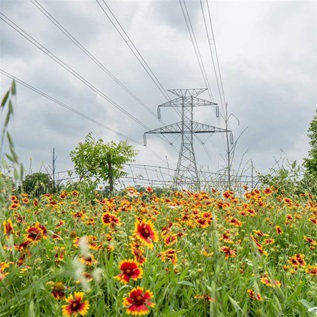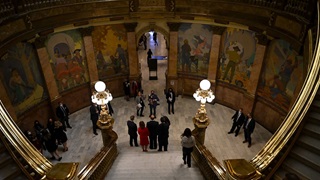States Rise to the Clean Energy Occasion
Historic federal incentives—and economic benefits—prompt creative state policies nationwide

Since the passage of the federal Infrastructure Investment and Jobs Act (IIJA) in 2021 and Inflation Reduction Act (IRA) in 2022, state policymakers have been working to capitalize on the historic levels of funding and new incentives that will support economic growth and help their states transition to clean energy. This work is particularly pressing because many of the incentives and programs created by Congress have funding caps or phaseout dates.
State lawmakers have developed a variety of innovative policies to be better prepared to compete for, and leverage, the opportunities made available by the IIJA and IRA. These include:
Matching funds to increase competitiveness
Federal agencies continue to develop guidance and allocate funding for various clean energy infrastructure programs, some of which require or encourage cost sharing or matching dollars. Some states are responding to the need for these dollars by appropriating funding to cover the match or cost share, thus increasing the competitiveness of applications to federal programs. For example, the Minnesota Legislature created a $100 million fund to provide grants to entities applying to federal energy programs that require or would benefit from matching funds. Michigan and Connecticut have dedicated funding that will help school districts better compete for awards from the Environmental Protection Agency’s Clean School Bus program. Although matching funds are not required under current EPA guidance, the agency is prioritizing applications that leverage additional funds, so these state dollars can boost the chances for a community’s grant approval.
State capacity building
For a state or local agency to effectively leverage federal funding, it must identify grant opportunities, develop applications, coordinate with stakeholders, and report on outcomes, among other tasks. Accordingly, some states have appropriated funding to increase their ability to access federal dollars. For example, the North Carolina General Assembly’s proposed budget includes $5 million to hire contractors to assist agencies with grant applications to federal programs. And Minnesota created a new position to pursue and manage federal funding opportunities. Actions such as these give state agencies a much-needed capacity boost to identify and secure available federal resources and also provide technical assistance to local governments and other stakeholders so they also can take better advantage of federal funding opportunities.
Complementary fiscal policy
The IRA contains numerous tax incentives to spur the adoption of clean energy alternatives for transportation, distributed power, and more. Now some states are amending their tax codes to offer credits and rebates to further encourage consumer and commercial adoption of these clean technologies.
For example, Colorado passed a $5,000 tax credit for buyers of qualifying electric and plug-in hybrid vehicles; the credit can be paired with federal tax credits of up to $7,500 for certain vehicles. Colorado also offers a $2,500 bonus credit for electric and plug-in hybrid vehicles that cost under $35,000 MSRP, which the Colorado Energy Office says can “help ensure electric cars aren’t luxury items” and can lead to more purchases of smaller vehicles. The state offers similar incentives for the purchase or lease of certain medium- and heavy-duty electric trucks, again complementing the federal tax credits for potential additional savings.
Pennsylvania’s General Assembly is considering an innovative funding approach to spur clean energy generation and save schools money on their utility bills through the proposed “Solar for Schools” program. The program would provide grants to help eligible schools cover the cost of solar panels. After installation, schools can recoup additional expenses through the “direct-pay” tax provisions in the IRA—which, like the broader set of tax credits in the law, allows for increased benefits if a project uses a certain percentage of domestic content; is located in an “energy community” that has legacy ties to fossil fuel production; or is in an eligible low-income community.
Coupled with federal tax credits, these complementary incentives can save consumers, businesses, and other entities considerable sums of money while electrifying the economy.
State incentives to boost workforce and manufacturing
The IRA also includes multiple investments, from tax credits and loan programs to research support, to encourage clean energy companies—such as makers of electric vehicles and batteries, solar panels, turbines, and other critical components—to launch or expand operations in the United States.
Complementing this, a number of states are working to attract these companies—and their significant job-creation potential. For example, in May, the Oklahoma Legislature passed a $180 million tax incentive package that will bring new job opportunities to the state. After passage of the measure, Italy-based Enel Green Power unveiled plans for a billion-dollar solar cell and panel manufacturing factory in the state, citing “tailwinds” from the IRA as a motivating force. Enel anticipates that the facility will create around 1,000 permanent jobs. Other states, from Arizona to South Carolina, have taken similar steps to secure new and expanded electric vehicle and battery manufacturing plants and reap the corresponding economic benefits.
States are also proactively taking stock of their workforce readiness and supply chain competitiveness for the clean energy transition. For example, this year the South Carolina and Louisiana legislatures advanced studies to examine the economic opportunities in the burgeoning offshore wind industry’s supply chain. These efforts are designed to identify competitive advantages while determining policy and financing gaps to help the two states attract industry investment. The studies may also allow the states to access federal funding with workforce or apprenticeship requirements and to support industries that are building or expanding operations as a result of new federal incentives.
Adjusting integrated resource plans
Most states have long directed some or all of the utilities in their jurisdictions to engage in regular planning for new investments and infrastructure. The specific requirements, timing, stakeholder participation opportunities, and other aspects of these integrated resource plans (IRPs) vary, and some states and public utility commissions have already leveraged IRPs to support clean energy goals. Connecticut’s IRP, for example, identifies strategies for achieving zero emissions by 2040 with affordable and reliable electricity statewide.
Because underlying cost assumptions of these IRPs can be a significant factor in the selection of energy investments, and the new federal programs in the IRA and IIJA have fundamentally altered energy economics, some IRPs may merit speedier updates with new assumptions. In Michigan, the utility commission and stakeholders pressed DTE Energy—the state’s largest utility—to revisit its most recent proposed IRP; the company’s reassessment recognized lower costs for renewables and storage, customer incentives for using heat pumps and other energy-saving technologies, and new financing options for retiring older plants—all associated with the enacted federal legislation. With these updates, DTE projected significant consumer savings under a revised plan that calls for replacing aging, economically inefficient coal plants in part with new renewable generation and storage.
The bottom line: Although the new federal programs and incentives created by the IRA and IIJA are essential, the nation’s transition to a clean energy economy also relies on states. Some states are making progress. But given the time-sensitive nature of many of the federal programs and incentives, others should move quickly to follow these innovative policy models.
Yaron Miller is a senior manager and Brian Watts is a principal associate with Pew’s energy modernization project.
Spotlight on Mental Health
MORE FROM PEW
Explore Pew’s new and improved
Fiscal 50 interactive
Your state's stats are more accessible than ever with our new and improved Fiscal 50 interactive:
- Maps, trends, and customizable charts
- 50-state rankings
- Analysis of what it all means
- Shareable graphics and downloadable data
- Proven fiscal policy strategies
Welcome to the new Fiscal 50
Key changes include:
- State pages that help you keep track of trends in your home state and provide national and regional context.
- Interactive indicator pages with highly customizable and shareable data visualizations.
- A Budget Threads feature that offers Pew’s read on the latest state fiscal news.















